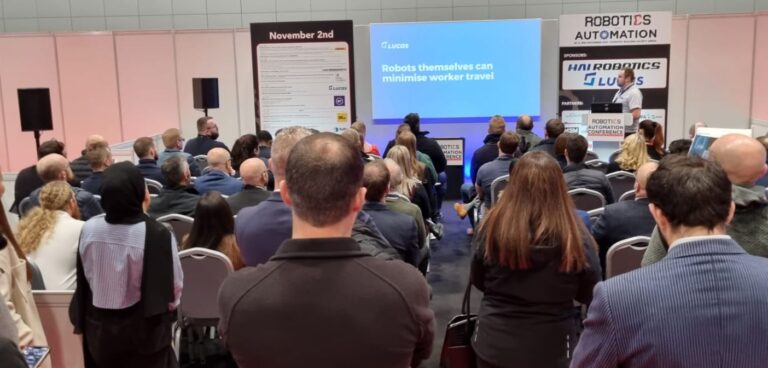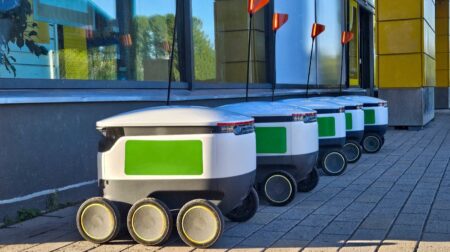The second and final day of the Robotics and Automation Conference offered visitors more unrivalled insight into the role cutting-edge technology is taking in transforming different industries and provided a comprehensive learning opportunity where industry leaders shared the secrets to operational success and real-world examples of how the latest technology can be applied to businesses.
The opening session came from Simon Woodward, head of accelerated innovation and digitalisation at DHL Supply Chain, who spoke about how robotics can be implemented in innovative ways to increase productivity as well as employee safety.
According to Woodward, “digitalisation underpins [DHL’s] strategy” for the future. He added: “There’s more robotics and automation, as you can see at this event here, and increasingly everything is being offered as a service. We need to respond to that.”

The second session saw Damien Skinner, country manager for the UK and Ireland at HAI Robotics, discuss the relationship between automation and e-commerce before revealing how to scale a warehouse solution in line with business growth.
“Choosing the right automation solution for your particular situation can be a daunting experience. Not only do you have to thoroughly analyse your current situation and requirements, but you also have to consider where your business will be at in the next five to 10 years,” said Skinner.
“After all, when investing in an automation solution you want it to be future proof. Experience tells us this can lead to companies investing in solutions that are overly complicated and expensive when it does not need to be.”
Skinner then walked attendees through a business case of a UK e-commerce company facing the same challenge and explained how HAI Robotics designed an automation solution that matched their current requirements, as well as a solution that can be scaled up along with the growth of their business.
Next, Lorraine Davis, director of cleaning and hygiene services at facilities management and professional services company Mitie, offered an insight into a range of sanitation robots, including a mist-spraying disinfectant device, as part of a session on the role of robotics in clean and safe environments.
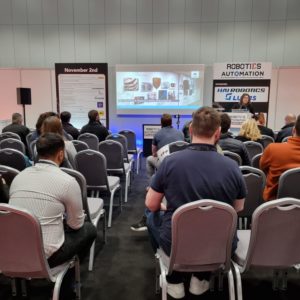
Davis explained how utilising robots to undertake some of the more strenuous and labour-intensive tasks frees up operatives to focus on tasks that require a greater level of thought and human input, resulting in more interesting and rewarding jobs, higher productivity, better cleaning quality and reduced cost.
Attendees then posed Davis with questions about deployment and implementation after her technical presentation on the shared problems between the UK and China around labour shortages and training issues when it came to sanitation services.
James Hart, business development manager at Lucas Systems, then dispelled five common myths of autonomous mobile robot (AMR) implementations and outlined how AI tools can optimise and orchestrate people and robots to support distribution centre objectives. He also explored the capabilities of AMRs and warehouse management software.
Following Hart’s session, Jon Wakeling, physical infrastructure engineer and acting Openreach research director at BT, spoke about the difficulty facing telecommunication companies when installing Fibre-to-the-Premise.
He alluded to the cost of digging trenches as an issue and claimed that BT spent “£2-3bn of deployment just digging”, which he described as a “massive inefficiency”. He went on to explain that, when looking into robotics to support BT’s work, he found it “difficult to find industrial partners […] so started working with universities”.
Wakeling revealed that BT has now awarded contracts to more than five universities around the UK including in Leeds, Bristol, and Glagow, for the development of new technology.
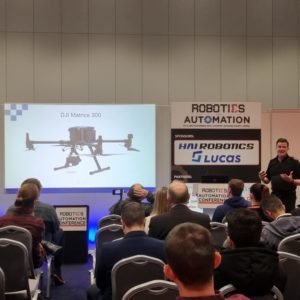
After the break, Will Kinghorn, industrial digital technology advisor at Made Smarter, offered guidance on how small to medium-sized manufacturing companies can grow through use of robotics and automation applications, with a short question and answer session at the end from visitors on finding the right digital tools.
This was followed by a speech from Nick Robson, head of robotics and automation at Huboo, who asked audience members to choose from a range of solutions in his presentation and invited them to guess which ones were more human-friendly. “The best solutions are not always given by a formula, it’s given by your gut and by your people,” he said.
Keith Bennett, police sergeant and chief drone pilot at West Midlands Police, then outlined the uses of drones to “preserve life and prevent and detect crime”.
Uses include gathering evidence, often in cases of slavery, drug trafficking, and exploitation. Drone functions for police work go beyond this however, such as shedding light on active crime scenes, assisting emergency services with handling natural disasters, and providing police teams with “live situational awareness” when dealing with anti-social behaviour and hooliganism. He added that drones “increase the efficiency of policing operations”, especially search-and-rescue operations.
Caroline Brown, enterprise development officer at North Lanarkshire Council, then took to the stage with a presentation on Smart Hub Lanarkshire – a partnership between North Lanarkshire Council, New College Lanarkshire and the University of Strathclyde, that acts as a home to a robotics and automation training facility and a dedicated space for SMEs to meet, learn and access business support and academic expertise.
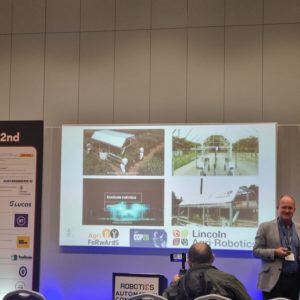
Brown shared market intelligence and details about the inception and early operating stages of the hub, as well as insights and learnings from 18 months of Smart Hub delivery, before finishing with an overview of project performance and scale up plans for the facility.
The final session of the day was delivered by Marc Hanheide, professor of intelligent robotics and interactive systems at the University of Lincoln, who provided insight into the recently completed Robot Highways project – the largest innovation demonstration of robotic automation in horticulture in the UK.
Hanheide discussed the automation of crop monitoring, treatment and harvesting at Clockhouse Farm – one of the UK’s largest strawberry farms – and how the project successfully showcased the coordination and integration of various robots to increase productivity and minimise economic inputs in production. What’s more, he explained how Robot Highways was able to exploit robotic technology while complementing human workers with a focus on human-robot collaboration.

